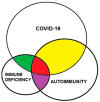Autoimmunity and Immunodeficiency in Severe SARS-CoV-2 Infection and Prolonged COVID-19
- PMID: 36661489
- PMCID: PMC9857622
- DOI: 10.3390/cimb45010003
Autoimmunity and Immunodeficiency in Severe SARS-CoV-2 Infection and Prolonged COVID-19
Abstract
SARS-CoV-2 causes the complex and heterogeneous illness known as COVID-19. The disease primarily affects the respiratory system but can quickly become systemic, harming multiple organs and leading to long-lasting sequelae in some patients. Most infected individuals are asymptomatic or present mild symptoms. Antibodies, complement, and immune cells can efficiently eliminate the virus. However, 20% of individuals develop severe respiratory illness and multiple organ failure. Virus replication has been described in several organs in patients who died from COVID-19, suggesting a compromised immune response. Immunodeficiency and autoimmunity are responsible for this impairment and facilitate viral escape. Mutations in IFN signal transduction and T cell activation are responsible for the inadequate response in young individuals. Autoantibodies are accountable for secondary immunodeficiency in patients with severe infection or prolonged COVID-19. Antibodies against cytokines (interferons α, γ and ω, IL1β, IL6, IL10, IL-17, IL21), chemokines, complement, nuclear proteins and DNA, anticardiolipin, and several extracellular proteins have been reported. The type and titer of autoantibodies depend on age and gender. Organ-specific autoantibodies have been described in prolonged COVID-19. Their role in the disease is under study. Autoimmunity and immunodeficiency should be screened as risk factors for severe or prolonged COVID-19.
Keywords: COVID-19; SARS-CoV-2; autoantibodies; autoimmunity; primary immune; prolonged COVID-19; secondary immunodeficiency.
Conflict of interest statement
The authors declare no conflict of interest.
Figures


Similar articles
-
Viral loads, lymphocyte subsets and cytokines in asymptomatic, mildly and critical symptomatic patients with SARS-CoV-2 infection: a retrospective study.Virol J. 2021 Jun 12;18(1):126. doi: 10.1186/s12985-021-01597-x. Virol J. 2021. PMID: 34118952 Free PMC article.
-
Interferons and other cytokines, genetics and beyond in COVID-19 and autoimmunity.Cytokine Growth Factor Rev. 2021 Apr;58:134-140. doi: 10.1016/j.cytogfr.2021.01.004. Epub 2021 Jan 29. Cytokine Growth Factor Rev. 2021. PMID: 33563543 Free PMC article. Review.
-
A comprehensive evaluation of the immune system response and type-I Interferon signaling pathway in hospitalized COVID-19 patients.Cell Commun Signal. 2022 Jul 16;20(1):106. doi: 10.1186/s12964-022-00903-6. Cell Commun Signal. 2022. PMID: 35842705 Free PMC article.
-
Severe COVID-19 represents an undiagnosed primary immunodeficiency in a high proportion of infected individuals.Clin Transl Immunology. 2022 Apr 17;11(4):e1365. doi: 10.1002/cti2.1365. eCollection 2022. Clin Transl Immunology. 2022. PMID: 35444807 Free PMC article. Review.
-
Autoimmunity is a hallmark of post-COVID syndrome.J Transl Med. 2022 Mar 16;20(1):129. doi: 10.1186/s12967-022-03328-4. J Transl Med. 2022. PMID: 35296346 Free PMC article.
Cited by
-
Exploring How Adipose Tissue, Obesity, and Gender Influence the Immune Response to Vaccines: A Comprehensive Narrative Review.Int J Mol Sci. 2025 Jan 20;26(2):862. doi: 10.3390/ijms26020862. Int J Mol Sci. 2025. PMID: 39859575 Free PMC article. Review.
-
Exploring the Contrasts and Similarities of Dengue and SARS-CoV-2 Infections During the COVID-19 Era.Int J Mol Sci. 2024 Oct 29;25(21):11624. doi: 10.3390/ijms252111624. Int J Mol Sci. 2024. PMID: 39519178 Free PMC article. Review.
-
Autoimmunity and long COVID in children.Reumatologia. 2023;61(6):492-501. doi: 10.5114/reum/176464. Epub 2024 Jan 18. Reumatologia. 2023. PMID: 38322108 Free PMC article.
-
The Omics Landscape of Long COVID-A Comprehensive Systematic Review to Advance Biomarker, Target and Drug Discovery.Allergy. 2025 Apr;80(4):932-948. doi: 10.1111/all.16526. Epub 2025 Mar 14. Allergy. 2025. PMID: 40084919 Free PMC article.
-
SARS-CoV-2 excretion and genetic evolution in nasopharyngeal and stool samples from primary immunodeficiency and immunocompetent pediatric patients.Virol J. 2025 Jan 13;22(1):9. doi: 10.1186/s12985-025-02628-7. Virol J. 2025. PMID: 39806466 Free PMC article.
References
-
- Kared H., Wolf A.S., Alirezaylavasani A., Ravussin A., Solum G., Tran T.T., Lund-Johansen F., Vaage J.T., Nissen-Meyer L.S., Nygaard U.C., et al. Immune responses in Omicron SARS-CoV-2 breakthrough infection in vaccinated adults. Nat. Commun. 2022;13:4165. doi: 10.1038/s41467-022-31888-y. - DOI - PMC - PubMed
Publication types
Grants and funding
LinkOut - more resources
Full Text Sources
Miscellaneous

